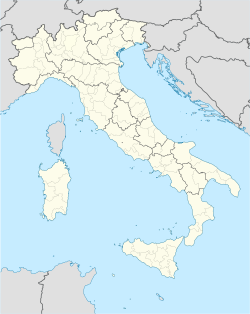Castelsardo Castheddu (Sassarese) | |
|---|---|
| Comune di Castelsardo | |
.jpg) | |
Location of Castelsardo  | |
| Coordinates: 40°55′N 8°43′E / 40.917°N 8.717°E | |
| Country | Italy |
| Region | Sardinia |
| Province | Sassari (SS) |
| Frazioni | Lu Bagnu, Multeddu, San Giovanni, Terra Bianca |
| Government | |
| • Mayor | Antonio Maria Capula |
| Area | |
| • Total | 43.34 km2 (16.73 sq mi) |
| Elevation | 114 m (374 ft) |
| Population (30 July 2017)[2] | |
| • Total | 5,994 |
| • Density | 140/km2 (360/sq mi) |
| Demonym(s) | Castellanesi |
| Time zone | UTC+1 (CET) |
| • Summer (DST) | UTC+2 (CEST) |
| Postal code | 07031 |
| Dialing code | 079 |
| Website | Official website |
Castelsardo (Sassarese: Castheddu; Sardinian: Casteddu Sardu) is a town and comune in Sardinia, Italy, located in the northwest of the island within the Province of Sassari, at the east end of the Gulf of Asinara.
History
Archaeological excavations have showed the human presence in the area of Castelsardo since pre-Nuragic and Nuragic times, as well as during the Roman domination in Sardinia.
After the fall of the Western Roman Empire, the monastery of Nostra Signora di Tergu was founded nearby, but the current town originates from the castle built here, in 1102 (or 1270), by the Doria family of Genoa. The castle and the village which gradually formed round it where the seat of the Doria's fiefdom in the island called Castel Doria or Castelgenovese, until it was conquered by the Aragonese in the 15th century (1448), and named Castillo Aragonés (Castel Aragonese). Except for the Maddalena archipelago, it was the last city in the island to join the Kingdom of Sardinia.
Castelsardo, was part of the Savoy's Kingdom of Sardinia, obtained by will of King Charles Emmanuel III.
Main sights
- Elephant's Rock, one of the symbols of Sardinia
- Megalithic walls, from pre-Nuragic times
- Nuraghe Paddaju and others
- Doria Castle (1102)
- Co-Cathedral, entitled to St. Anthony the Abbot. The crypts house the Museum "Maestro di Castelsardo";
- Church of St. Mary, with a wooden Black Christ
- Doria Palace
- La Loggia Palace, town hall since 1111
- Palace of Eleonora of Arborea
- Sea walls
References
 This article incorporates text from a publication now in the public domain: Herbermann, Charles, ed. (1913). Catholic Encyclopedia. New York: Robert Appleton Company. CATHOLIC ENCYCLOPEDIA: Ampurias
This article incorporates text from a publication now in the public domain: Herbermann, Charles, ed. (1913). Catholic Encyclopedia. New York: Robert Appleton Company. CATHOLIC ENCYCLOPEDIA: Ampurias
- ^ "Superficie di Comuni Province e Regioni italiane al 9 ottobre 2011". Istat. Retrieved 16 March 2019.
- ^ "Popolazione Residente al 1° Gennaio 2018". Istat. Retrieved 16 March 2019.

